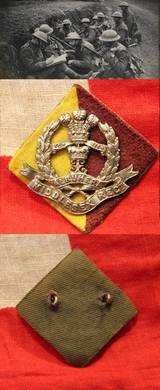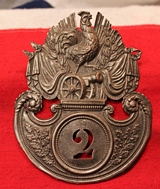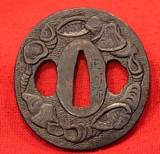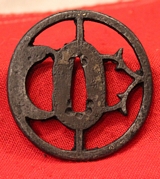Royal Gurkha Rifles, Pouch Belt Badge & Plate - Silver Plate "Come and fight a Gurkha!" Gurkha Lachhiman Gurung VC Who Single Handedly Fought Off & Beat 200 Japanese With One Hand Blown Off & Blinded in 1 Eye By Grenade
Considered to be one of the greatest and bravest regiments in the world. The very finest men to fight alongside, and the very, very worst to fight against.
"Ayo Gorkali" the battle cry of the Gurkhas, "The Gurkhas Are Coming", has been known to instill terror in any confronted enemy of the Gurkhas. Many battle hardened Japanese infantrymen in WW2, and Argentinian soldiers in The Falklands were known to have run and fled or surrendered immediately upon that battle cry being heard.
The Royal Gurkha Rifles (RGR) is a rifle regiment of the British Army, forming part of the Brigade of Gurkhas. Unlike other regiments in the British Army, RGR soldiers are recruited from Nepal, which is neither a dependent territory of the United Kingdom nor a member of the Commonwealth.
Just one example of Gurkha heroism is Corporal Dip Prasad Pun of the 1st battalion (1 RGR) was awarded the Conspicuous Gallantry Cross for an act of bravery during the War in Afghanistan in 2010. He alone defended his outpost against a force of up to 12 Taliban fighters. He fired more than 400 rounds, 17 grenades, and one mine. He resorted to fighting with his machine gun tripod after his ammunition had run out
The battle honours of the Royal Gurkha Rifles are as follows:29
Amboor, Carnatic, Mysore 1792, Assaye 1803, Ava 1852, Burma 1885–87, Bhurtpore, Aliwal, Sobraon, Delhi 1857, Kabul 1879, Afghanistan 1878–80, Kandahar 1880, Tirah, Punjab Frontier, Afghanistan 1919
First World War: La Bassée 1914, Festubert 1914–15, Givenchy 1914, Neuve Chapelle, Aubers, Loos, France and Flanders 1914–15, Egypt 1915, Tigris 1916, Kut al Amara 1917, Baghdad, Mesopotamia 1916–18, Persia 1918, Baluchistan 1918, Helles, Krithia, Suvla, Sari Bair, Gallipoli 1915, Suez Canal, Egypt 1915–16, Khan Baghdadi, Mesopotamia 1916–18, Persia 1916–1918, North West Frontier India 1915–17, Egypt 1915, Megiddo, Sharon, Palestine 1918, Shaiba, Kut al Amara 1915–17, Ctesiphon, Defence of Kut al Amara, Baghdad, Sharqat, Mesopotamia 1915–18
The Second World War: Tobruk 1942, El Alamein, Akarit, Tunis, Cassino 1, Poggio Del Grillo, Gothic Line, Tavoleto, Coriano, Santacangelo, Monte Chicco, Bologna, Medicina, Italy 1944-45, Jitra, Slim River, Sittang 1942, 1945, Kyaukse 1942, 1945, North Arakan, Imphal, Tuitum, Bishenpur, Tengnoupal, Shwebo, Kyaukmyaung Bridgehead, Mandalay, Myinmu Bridgehead, Fort Dufferin, Meiktila, Irrawaddy, Rangoon Road, Chindits 1943,44 & 45, Tamandu, Maymyo
Falklands War.
Picture 8 in the gallery is of Jemadar Jangia Bullets Thapa, 5th Gurkha Regiment, 1890
One of Major-General Frederick Roberts's orderlies during the 2nd Afghan War (1878-1880), Jemadar Jangia Thapa was nicknamed 'Bullets' because regimental tradition had it that he had once been hit on the forehead by a bullet which had been completely flattened without causing him the least discomfort. Thapa was admitted to the Second Class of the Order of British India in April 1897 and was selected as one of the representatives for India at the inauguration of the Australian Commonwealth in January 1901.
One of the most famous Gurkhas in the British Army
Lachhiman Gurung VC ( 30 December 1917 – 12 December 2010) was a Nepalese–British Gurkha recipient of the Victoria Cross, the highest and most prestigious award for gallantry in the face of the enemy that can be awarded to British and Commonwealth forces. He is best known as the "Gurkha who took on 200 soldiers with only one hand" because of his actions in World War II.
On 12/13 May 1945 at Taungdaw, Burma now Myanmar, Rifleman Lachhiman Gurung was manning the most forward post of his platoon which bore the brunt of an attack by at least 200 of the Japanese enemy. He hurled back two hand grenades which had fallen on his trench, but the third exploded in his right hand after he attempted to throw it back, blowing off his fingers, shattering his arm and severely wounding him in the face, body and right leg. His two comrades were also badly wounded but the rifleman, now alone and disregarding his wounds, loaded and fired his rifle with his left hand for four hours (all while he screamed "Come and fight a Gurkha!"), calmly waiting for each attack which he met with fire at point blank range.
His citation in the London Gazette ends with...
...Of the 87 enemy dead counted in the immediate vicinity of the Company locality, 31 lay in front of this Rifleman's section, the key to the whole position. Had the enemy succeeded in over-running and occupying Rifleman Lachhiman Gurung's trench, the whole of the reverse slope position would have been completely dominated and turned.
This Rifleman, by his magnificent example, so inspired his comrades to resist the enemy to the last, that, although surrounded and cut off for three days and two nights, they held and smashed every attack.
His outstanding gallantry and extreme devotion to duty, in the face of almost overwhelming odds, were the main factors in the defeat of the enemy.1
He received his Victoria Cross from the Viceroy of India, Field Marshal Lord Wavell at the Red Fort in Delhi on 19 December 1945
Four threaded mounting screw posts, with two affixing rounded nuts present.
93mm x 75mm read more
140.00 GBP
A Rare Original Handwritten German Picture Postcard From Hitler's Titanic, One of The Most Famous Ships of WW2. German Ship Sunk By Soviet Submarine with the Loss of up to 11,000 Lives Making It The Greatest Loss in Worldwide Maritime History
It is most rare to find an original, dated, addressed and handwritten postcard from the Willhelm Gustloff.
MV Wilhelm Gustloff was a German military transport ship which was sunk on 30 January 1945 by Soviet submarine S-13 in the Baltic Sea while evacuating civilian evacuees from East Prussia, Lithuania, Latvia, Poland and Estonia and German military personnel from Gotenhafen (Gdynia) as the Red Army advanced. By one estimate, 9,400 people died, making it the largest loss of life in a single ship sinking in history.
Originally constructed as a cruise ship for the Nazi Strength Through Joy (Kraft durch Freude) organization in 1937, Wilhelm Gustloff had been requisitioned by the Kriegsmarine (German navy) in 1939. She served as a hospital ship in 1939 and 1940. She was then assigned as a floating barracks for naval personnel in Gotenhafen before being fitted with anti-aircraft guns and put into service to transport evacuees in 1945.
Headline from a German newspaper recording the disaster, translation;
"Wilhelm Gustloff" - Disaster
Party stormed with inquiries
The offices of the Party and the Navy in all parts of the Reich were yesterday stormed by anxious persons, who suspect that their relatives were perhaps onboard the "Wilhelm Gustloff", which was torpedoed by a Russian submarine on January 30th at 9:00 pm in the Danzig Bay and sunk within 15 minutes. The number of victims of the "Wilhelm Gustloff" disaster is still not certain, since no office of the Party or of the Kriegsmarine can accurately say, how many Eastern refugees and members of the Wehrmacht were on board, when the ship left Gotenhafen.
932 saved
On the basis of the latest research, it must be assumed that not 8,000, as we reported yesterday, but 10 to 11,000 passengers were on board. Only 932 were saved. Of which 658 were members of the Kriegsmarine. Serious accusations are now being raised against the Danzig Party offices, who insisted that the "Wilhelm Gustloff" should depart on January 30th, even though the head of the Security Baltic Sea had pointed out that the necessary number of security units could not be placed before February 4.
The "Wilhelm Gustloff" departed nevertheless on the 30th of January in the evening with the completely inadequate securing from an outpost boat and two R-boats. All the decks of the "Wilhelm Gustloff" were so crowded that no one could move. At the embarkation it was said, the journey takes however only a few hours.When the ship was hit by the Russian torpedo at exactly 9 o'clock pm, just an hour after the departure, hardly anybody could escape from the lower decks. Many passengers were thrown into the sea at the time the ship capsized, frozen in the icy water before they could be helped.
Survivors report the horror scene, which took place after the explosion onboard the ship. All lights on board are extinguished at a stroke. In wild panic, the passengers tried to find a way to the deck despite the darkness. Hundreds of women and children were trampled to death on the stairs and corridors.
Women and children
In the fierce battle that took place around the few rescue boats, women and children were ruthlessly pushed overboard. After just ten minutes, the 25,000 - ton ship listed hard. Five minutes later, the "Wilhelm Gustloff" capsized and took many thousands with her into the depth. Others, who had fallen from the deck or hurled into the sea, fell into the wake of the sinking ship and disappeared into the flood. The "Wilhelm Gustloff" was finished in 1937 as a KdF ship and was taken over by the Kriegsmarine in 1940 first as a hospital ship. Since March 1941 she was the home of the submarine teaching division in Gotenhafen.
The newspaper is shown for education purposes only read more
45.00 GBP
A Most Scarce Third Reich Period Deutche Luftfahrt/DLV Officer's Visor Cap Insignia, German Flyers Associoation
DLV (German Flyers Association). The German Air Sports Association (Deutscher Luftsportverband, or DLV e. V.) was an organisation set up by the Nazi Party in March 1933 to establish a uniform basis for the training of military pilots. Its chairman was Hermann Göring and its vice-chairman Ernst Röhm. Since the Treaty of Versailles officially forbade Germany from building fighter planes of any sort, the German Air Sports Association used gliders to train men still officially civilians for the future Luftwaffe. The first steps towards the Luftwaffe's formation were undertaken just months after Adolf Hitler came to power. Hermann Göring, a World War I ace with 22 victories and the holder of the Orden Pour le Mérite, became National Kommissar for aviation with former Deutsche Luft Hansa director Erhard Milch as his deputy. On 25 March 1933 the German Air Sports Association absorbed all private and national organizations, whilst retaining its 'sports' title. In April 1933 the Reichsluftfahrtministerium (RLM – Reich Air Ministry) was established. The RLM was in charge of development and production of aircraft, and soon afterwards the test site or Erprobungsstelle at Rechlin became its testing ground, a military airfield that had been first established in August 1918. Göring's control over all aspects of aviation became absolute.
The German Air Sports Association was dissolved in 1937 and replaced with the National Socialist Flyers Corps, a corporation under public law and subordinate to Reichsluftfahrtminister Göring. read more
140.00 GBP
WW1 Middlesex Regt. Officer's Silver Cap Badge, With Rare Battalion Battle Patch
The battalion battle patch, is a very rare surviving piece of divisional command identification, here, it is set mounted behind the silver badge, as the colour designation of the regiment, and in WW1 it was often used thus so on the tropical helmet with the helmet badge together, it could also be sown separately on the uniform as a patch, with the silver badge affixed as usual on the cap, and it is very rare to see complete, the patch with its silver officer’s badge.
On the Brodie helmet it would be added as a painted regimental badge for identification.
The 1st Battalion landed at Le Havre, as line of communication troops, in August 1914 for service on the Western Front.
Lieutenant-Colonel John Hamilton Hall (standing directly in front of the Red Cross on the ambulance), the CO of the 1st Battalion, Middlesex Regiment (98th Brigade, 33rd Division), with his officers. Photograph taken during the battalion's rest near Cassel, 25 April 1918.
The 2nd Battalion landed at Le Havre as part of the 23rd Brigade in the 8th Division in November 1914 also for service on the Western Front.[18]
The 3rd Battalion landed at Le Havre aspart of the 85th Brigade in the 28th Division in January 1915 for service on the Western Front before moving to Egypt in October 1915 and to Salonika in December 1915.
The 4th Battalion land at Boulogne-sur-Mer as part of the 8th Brigade in 3rd Division in August 1914 for service on the Western Front. Some 400 men of the 4th Battalion were killed at the Battle of Mons later that month read more
165.00 GBP
A French 1830's Belltop Shako Helmet Plate 2nd Regiment
Louis Philippe I (6 October 1773 - 26 August 1850) was King of the French from 1830 to 1848 as the leader of the Orleanist party. As a member of the cadet branch of the Royal House of France and a cousin of King Louis XVI of France by reason of his descent from their common ancestors Louis XIII and Louis XIV of France, he had earlier found it necessary to flee France during the period of the French Revolution in order to avoid imprisonment and execution, a fate that actually befell his father Louis Philippe II, Duke of Orleans. He spent 21 years in exile after he left France in 1793. He was proclaimed king in 1830 after his cousin Charles X was forced to abdicate in the wake of the events of the July Revolution of that year. His government, known as the July Monarchy, was dominated by members of a wealthy French elite and numerous former Napoleonic officials. He followed conservative policies, especially under the influence of the French statesman Francois Guizot during the period 1840-48. He also promoted friendship with Britain and sponsored colonial expansion, notably the conquest of Algeria. His popularity faded as economic conditions in France deteriorated in 1847, and he was forced to abdicate after the outbreak of the French Revolution of 1848. He lived out his life in exile in Great Britain. read more
125.00 GBP
A Victorian, Stilleto Style, So-Called Prostitute’s Dagger
With very attractive pressed ivorine handle made to simulate ivory. A prostitutes dagger was so called due to their attractiveness and useful size for concealment by unaccompanied ladies abroad after dark. Of course they would never have been sold as such by retailers, and the term has entered the vernacular of collectors probably even after the time they were actually made, however, like the term 'mortuary hilted swords' that bore the engraved visage of the king in the hilt from the English Civil War, they were never actually called that until almost 200 years later. They are attractively designed elegant daggers, just such as this one, with a slender and most efficient blade. Prostitution became a major concern and a focal point for social reformers in the 19th century. Concerns were seen everywhere including the literature of notables such as Charles Dickens. He created characters (some of which may have had real life versions) like Nancy in Oliver Twist, and Martha Endell in David Copperfield.
No one knows for certain, but there were somewhere between 8,000 and 80,000 prostitutes in London during the Victorian Age. It is generally accepted that most of these women found themselves in prostitution due to economic necessity.
There were three attitudes towards prostitution – condemnation, regulation, and reformation. Dickens adopted the last and was intimately involved in a house of reform called Urania Cottage. No scabbard Blade 4.25 inches, overall 8.25 inches long read more
275.00 GBP
A Good Antique Edo Period Round Signed Tetsu Wakazashi Tsuba Embossed Seashells
A delightful iron round tsuba takebori patterned with various shells over a water pattern background, with ana openings for kozuka and kogai. The Tsuba can be solid, semi pierced of fully pierced, with an overall perforated design, but it always a central opening which narrows at its peak for the blade to fit within. It often can have openings for the kozuka and kogai to pass through, and these openings can also often be filled with metal to seal them closed. For the Samurai, it also functioned as an article of distinction, as his sole personal ornament 61 mm read more
225.00 GBP
An Edo O Sukashi Wakazashi or Tanto Tsuba In Iron
Circa 1650. The Tsuba, or Japanese sword guard, is a refined utilitarian object. It is essentially a sheath for the blade to fit through, protecting the hand of the warrior. The Tsuba can be solid, semi pierced of fully pierced, with an overall perforated design, but it always a central opening which narrows at its peak for the blade to fit within. It often can have openings for the kozuka and kogai to pass through, and these openings can also also often be filled with metal to seal them closed. For the Samurai, it also functioned as an article of distinction, as his sole personal ornament. read more
265.00 GBP
Rifle Brigade Victorian OR’s Helmet Plate
An excellent example, die-stamped blackened on two loops. Within a laurel wreath surmounted by a Guelphic Crown resting on a tablet inscribed Waterloo, a Maltese cross with lions between the arms and ball finials to the tips. The arms of the cross bear numerous honours; the wreath bears honours Sevastopol Alma Inkerman. Between the bottom arm of the cross and the wreath, three scrolls Lucknow over Peninsula with Ashantee below; across the base of the wreath, a scroll The Prince Consort’s Own’
9.5cm high read more
175.00 GBP
The Lanes Armoury & The Hawkins Family Established For Over 100 Years
In fact the family has been trading in Brighton for likely 200 years, but the first 100 Years was in the local fish and shellfish trade, becoming shopkeepers in antiques in the town in the last 100 years. Apparently the family moved from our seafaring roots in Plymouth, around 200 years ago, where we had been trading since the 1500’s, and during reign of The Tudors, Admiral Sir Francis Drake had been an adopted apprentice from the age of 15 of the Hawkins family in Plymouth..
The current partners, Mark and David have between them almost 95 years combined service to the company, serving the public and trade in ‘The Lanes’ of Brighton. In fact, we believe, out of approximately 2000 shops, and goodness knows how many businesses in the city, we are now the oldest, remaining, established family traders within the whole of Brighton and Hove.
BRIGHTON and Hove has been named the second-best area for independent shopping in the United Kingdom, only just pipped at the post by Cambridge. If you are going to be beaten by a town at least it was Cambridge [apologies to Oxford, but you ought to be used to it by now]
Taken from the Brighton and Hove.gov website; ‘The Lanes’ is listed first of the four main shopping areas; ‘ The Lanes - historic maze of alleyways with a mix of antiques, jewellery and fashion’
But sadly, we are the only antique and bookshop now still remaining in ‘The Lanes’ read more
Price
on
Request











